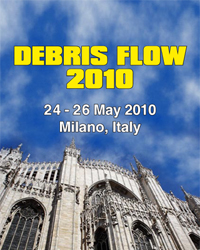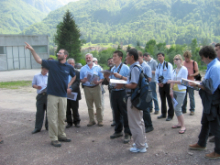Third International Conference on Debris Flow
24 - 26 May 2010
Milano, Italy
Overview
 The third International Conference on Modelling, Simulation, Prevention and Rehabilitation of Dense Debris Flow has recently taken place in Milano, organised by the Wessex Institute of Technology, represented by Professor Carlos A Brebbia, and the University of Milano, represented by Professor Danielle de Wrachien. The meeting was also sponsored by the Lombardy Region and supported by the European Society of Agricultural Engineers (EurAgEng), the International Commission of Agricultural Engineering (CIGR) and the International Commission on Irrigation and Drainage (ICID).
The third International Conference on Modelling, Simulation, Prevention and Rehabilitation of Dense Debris Flow has recently taken place in Milano, organised by the Wessex Institute of Technology, represented by Professor Carlos A Brebbia, and the University of Milano, represented by Professor Danielle de Wrachien. The meeting was also sponsored by the Lombardy Region and supported by the European Society of Agricultural Engineers (EurAgEng), the International Commission of Agricultural Engineering (CIGR) and the International Commission on Irrigation and Drainage (ICID).
This successful series of conferences first started in Rhodes (2006) and continued in the New Forest Campus of WIT (2008).
Debris and hyper-concentrated flows are amongst the most destructive of all water-related disasters. They affect both rural and urban areas in a wide variety of morphoclimatic environments. In recent years they have attracted more and more attention from the scientific and professional communities and concern from the public due to the death toll they claim. The increased frequency of these natural hazards, coupled with climatic change, pollution and urban developments, suggests that they are set to increase in the future.
Opening Addresses
Professor Danielle de Wrachien opened the conference stressing that greater research needs to be directed towards understanding the nature of regional disasters, hydrological systems, geological processes, and ideally the variability and potential for change. Such knowledge plays a role of paramount importance in order to estimate the potential frequency of these flows.
“Developments in modelling, satellite communication and information technology are essential for improving mitigation measures and mathematical models for forecasting and early warning of impending hazards. The challenge for the international community is to support these activities, particularly in developing countries, where reasources for such activities are limited. Field studies are the most difficult to task with this approach.”
“The ideal sequence that should be pursued in the approach to the difficult problem of the management and mitigation of hyper-concentrated and debris flows can be outlined as follows”;
i. A systematic collection of field data should be carried out in order to provide a large database of reliable data.
ii. Effective mathematical models should be constantly developed, updated, tested and applied.
iii. Hydrological mapping techniques and identification of possible scenarios, should then be set up
iv. The best mitigation solutions should be designed and implemented on the basis of the knowledge achieved in the planning system.
v. Following a programme of systematic observations at the sites, where risk has been mitigated. They should be planned and carried out to detect any shortcomings and to test the efficiency of the investigation.
“This concept ought to lead to an integrated risk management approach which comprises the systematic process, administrative decisions, organisation, operational skill and ability to implement policies, strategies and coping capacity of the society and the communities to lessen the impact of natural hazards and related environmental disasters.”
Professor Carlos Brebbia then welcomed the delegates in the name of the Wessex Institute of Technology (WIT) explaining the importance of those meetings within the objectives of his institute. WIT – Professor Brebbia said – aims to act as a mechanism to transfer knowledge amongst many different specialities and parties, covering professionals in practice as well as those in academia and research.
The emphasis is on interdisciplinary activities, such as those reported in the conference, which are a wide range of topics and specialities.
WIT is not only renown for its work on advanced computer modelling but it also distributes up to date information around the world. The results of this meeting for instance are now being widely distributed in digital as well as paper format. Professor Brebbia also hoped that the authors will consider preparing extended version of the paper for inclusion in any two of the Journals, i.e. International Journal of Sustainable Development and Planning or the International Journal of Safety and Security, both run by the Institution.
Professor Brebbia also invited all participants to visit the WIT Campus in the New Forest and consider spending some time talking to the researchers. The New Forest, Professor Brebbia described, is a region of outstanding natural beauty and is located conveniently near London and its two major airports.
Conference Sessions
 The conference papers covered a variety of interesting topics;
The conference papers covered a variety of interesting topics;
- Debris Flow Modelling
- Sediment Transport and Debris Flow Monitoring and Analysis
- Risk Assessment and Hazard Mitigation
- Debris Flow Triggering
- Flood Forecasting and Case Studies
- Risk Assessment and Decision Making
Invited Presentations
There were a series of invited presentations given by well-known colleagues to enhance the meeting;
‘Mechanical and fluid-dynamic behaviour of debris and hyper-concentrated flows: overview and challenges’
Daniele De Wrachien, University of Milano, Italy
This paper reviews the most up-to-date and effective geotechnical and fluid-dynamic procedures currently available, suitable for predicting the triggering and mobilisation processes of these phenomena and proposes a mathematical model that is able to assess the depth of the wave and the velocities of the liquid and solid phases.
‘One-dimensional finite volume simulation of real debris flow events’
Sara Pavan, University of Ferrara, Italy
The paper describes the application of a one-dimensional finite volume model, originating from channels of complex geometry extended to the case of real world debris flow events.
‘Debris flow modelling accounting for large boulder transport’
Cora Martinez, Florida International University, USA
This paper presents a quasi-tri- dimensional numerical model to simulate strong debris flow, considering water and fine sediments as a continuous fluid phase and boulders and large particles as a non-continuous solid phase.
‘Monitoring and Transfer Processes of Sediment-LW in mountain catchments’
Mario Aristide Lenzi, University of Padova, Italy
‘The distribution of debris flows and debris flow hazards in southeast China’
Fangqiang Wei, Chinese Academy of Sciences, China
A number of recent disastrous debris flows in southeast China have drawn the attention of researchers and the government. Using historical data and field investigations, the paper describes flow distribution, causes and contributing factors, hazards and disaster prevention plus the mitigation measures applied in southeast China.
Sessions on Sediment Transport and Debris Flow Monitoring
The conference programme comprised of two split sessions on Sediment Transport and Debris Flow Monitoring and Analysis organised by Professor M.A. Leigh from the Politecnico di Milano, consisting of six excellent presentations describing a series of case studies.
Technical Visit
 The conference included a technical visit organised by the Lombardy region. The delegates visited Cortenova, a place in the province of Lecco which is famous for the occurrence of a large landslide phenomena. The base of the slope has supported the effects of a collapse that affected the village of Bindo and caused widespread damage to homes and farm properties. Nearby they also found evidence of the debris flow which was channelled into the Rossiga torrent at the time.
The conference included a technical visit organised by the Lombardy region. The delegates visited Cortenova, a place in the province of Lecco which is famous for the occurrence of a large landslide phenomena. The base of the slope has supported the effects of a collapse that affected the village of Bindo and caused widespread damage to homes and farm properties. Nearby they also found evidence of the debris flow which was channelled into the Rossiga torrent at the time.
The collapse of the slope in Bindo was forecasted by the geologists for the Lombardy region who in the night of November 30, 2002 decided to evacuate the area, based on perceived ground movements and the turbid appearance of the water at the bottom of the slope, events preceeding an eminent landslide. The emergency plan consisted of moving 500 people from the area which was a very fortunate move as on December 1st a landslip of about one million m3 came down on Bindo destroying 13 homes and some farm buildings.
Following this event the Lombardy region installed a monitoring system. Measurements are transmitted to a geological office. An emergency plan has been prepared in which threshold risks have been defined based on the correlation of precipitation and earth movements.
The delegates were shown the sites and described the work in progress by Lombardy region staff. They had occasion to see the two sites, i.e. the major landslide and the site of the torrent flow. Earth works have been constructed to mitigate the effects of any future landslides and the site of any future torrent flow protected by newly built channels.
The delegates had ample opportunity for asking the experts questions to better understand the work carried in the region. Italy is a country with a large number of geologic disasters, including landslides which over the years have caused substantial losses in terms of lives and the economy.
Conference Dinner
 The conference dinner took place in a restaurant renown for the excellence of its fish courses and accompanying white wines. The occasion was friendly and relaxed and the dinner was yet another occasion to help the delegates get to know each other better. At the end of the dinner the conference Chairmen gave the participants a guide to the Artistic Treasures of Milano to help them to find out more about this unique city and to mark the success of Debris Flow 2010.
The conference dinner took place in a restaurant renown for the excellence of its fish courses and accompanying white wines. The occasion was friendly and relaxed and the dinner was yet another occasion to help the delegates get to know each other better. At the end of the dinner the conference Chairmen gave the participants a guide to the Artistic Treasures of Milano to help them to find out more about this unique city and to mark the success of Debris Flow 2010.
The conference brought together engineers, scientists and managers from across the globe to discuss the latest scientific advances in the field of debris and hyper-concentrated flow, as well as to improve models, assess risks, develop hydrological maps based on model results and to design preventative and mitigation measures.
There were many opportunities for interaction during the meeting, mostly during coffee and lunch breaks but also at the conference dinner and in particular the excursion.
The success of the meeting will ensure that the conference can be reconvened in 2012 at a location and on a date to be shortly announced.
Publication of Proceedings
The proceedings of Debris Flow III, 288pp (Print ISBN: 978-1-84564-442-0; Online ISSN: 1743-3533) are available from WIT Press priced at £109/US$218/€153. Orders can be placed online at www.witpress.com or by email:
Papers from the conference will also be hosted online in the WIT eLibrary as Volume 67 of WIT Transactions on Engineering Sciences (ISSN: 1743-3533). For more details visit the WIT eLibrary at http://library.witpress.com


 Wessex Institute
Wessex Institute